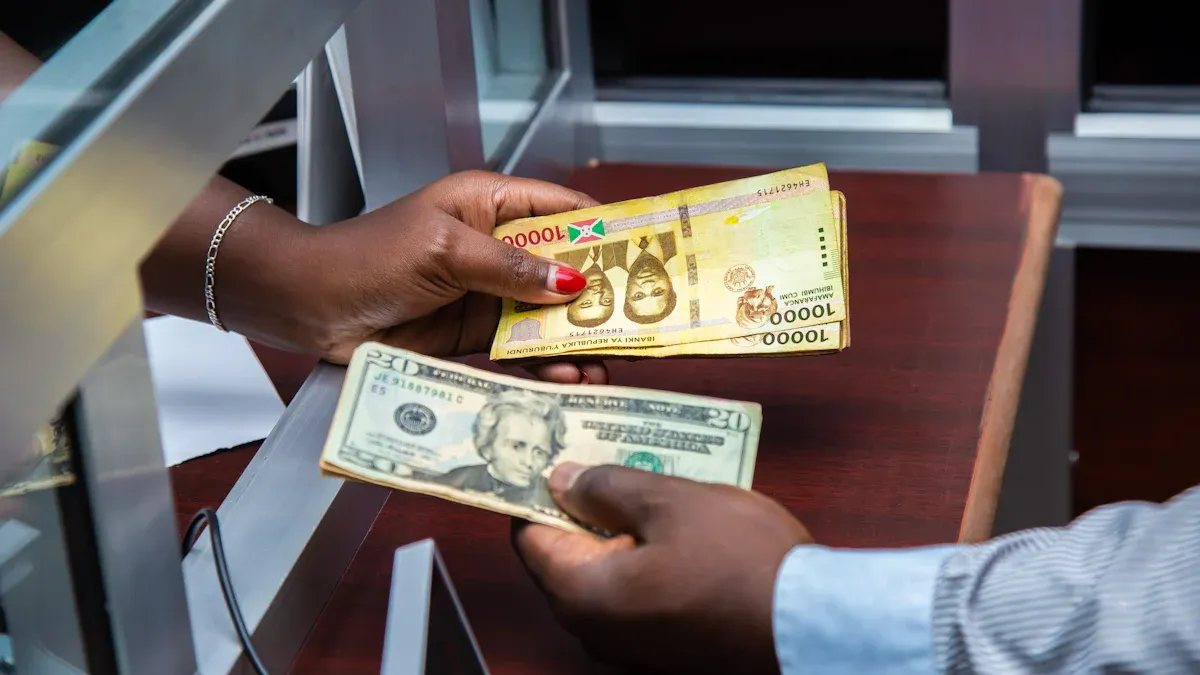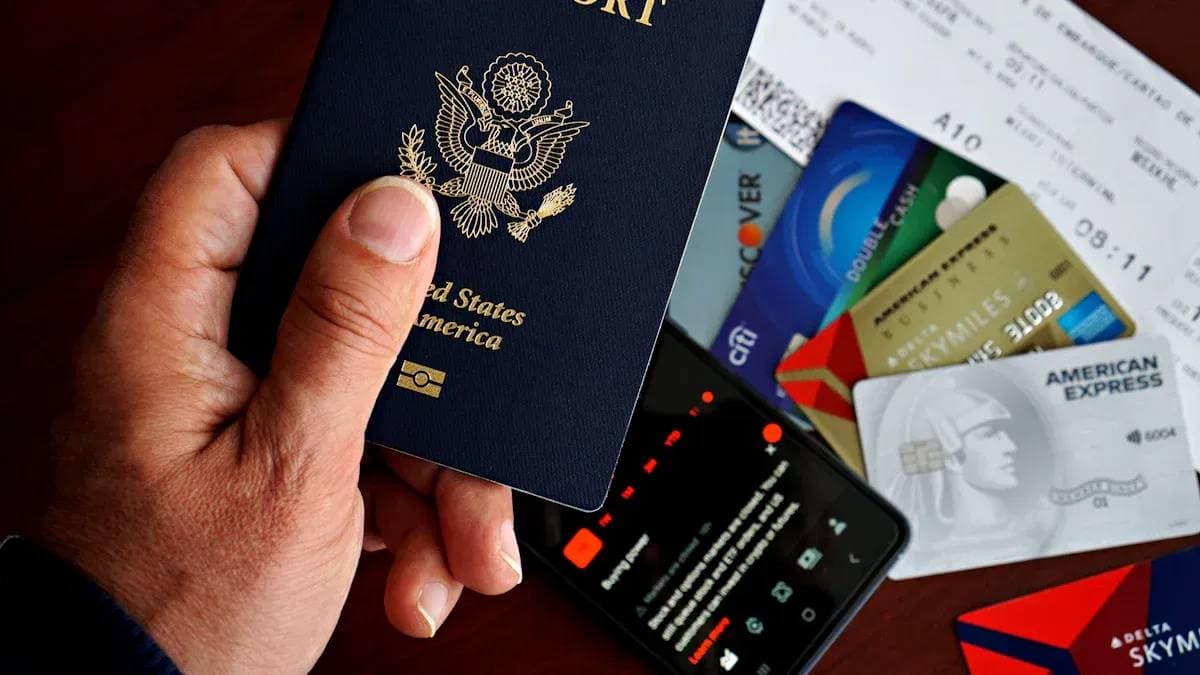- EasyCard
- Trade
- Help
- Announcement
- Academy
- SWIFT Code
- Iban Number
- Referral
- Customer Service
- Blog
- Creator
Must-Know for Large Remittances to Family: Full Analysis of Reporting, Tax, and Compliance Points

Image Source: pexels
Are you planning to remit money from mainland China to fund your family’s home purchase in the United States? You may immediately encounter several questions:
- Is there a limit on the remittance amount?
- Do I need to report to the government?
- Will this money be taxed?
These questions directly relate to your fund security. Clearly understanding the relevant rules is the first step to mastering remittance safety and compliance points, helping you avoid unnecessary trouble.
Key Takeaways
- Understanding remittance reporting rules is important. Banks automatically report large cash transactions and suspicious activities. As a recipient, if your overseas account total exceeds $10,000, you need to file FBAR yourself; if you receive overseas gifts exceeding $100,000, you need to file Form 3520.
- Avoid “ant-moving” style remittances. Splitting large funds into small remittances is illegal; even if the funds are from legitimate sources, this behavior can lead to huge fines and legal issues.
- Make good use of gift tax exemptions. The U.S. has annual gift tax exclusions and lifetime gift tax exemptions. The donor usually bears the gift tax, while the recipient generally does not pay tax but may need to report.
- Choose formal remittance channels and keep all records. Use regulated banks or remittance companies. Prepare a gift letter, correctly fill in the remittance memo, and properly store all transaction vouchers and reporting documents for future verification.
Remittance Reporting Basics: Who Reports and to Whom

Image Source: unsplash
Many people mistakenly believe that every large remittance requires personal reporting to the U.S. government. This is a common misconception. In fact, the reporting responsibility varies. Some reports are automatically completed by banks, while others require you as the recipient to proactively file. Clearly distinguishing between the two is the first step to mastering remittance safety and compliance points.
Bank’s Automatic Reporting Obligations (CTR & SAR)
When you receive a remittance from overseas, the receiving bank in the U.S. has statutory reporting obligations. These reports are submitted directly by the bank to government agencies, and you usually do not need to intervene.
- Currency Transaction Report (CTR) Banking regulations require submitting a CTR for most cash transactions exceeding $10,000. This “transaction” is cumulatively calculated. For example, if you deposit $8,000 in cash in the morning and another $3,000 in the afternoon on the same business day, totaling $11,000, the bank must submit a CTR. This is a routine bank operation to assist the government in tracking large cash flows.
- Suspicious Activity Report (SAR) If the bank deems a transaction suspicious, regardless of the amount, it will submit an SAR. What counts as suspicious?
- Transaction behavior inconsistent with your account history or professional background.
- Frequent transfers to high-risk regions.
- Attempts to evade reporting, such as deliberately splitting large transactions into multiple small ones.
Important Note: A bank submitting a CTR or SAR does not mean you did something wrong. CTR is a routine process, while SAR is the bank fulfilling its anti-money laundering obligations. However, if your transaction pattern triggers an SAR, it may attract regulatory attention.
Individual Overseas Account Reporting (FBAR)
This reporting obligation is unrelated to the bank and must be proactively completed by you as a U.S. tax resident.
If you are a U.S. citizen, green card holder, or tax resident living in the U.S. for a certain period, and the total value of all your financial accounts overseas (such as in mainland China or Hong Kong) exceeds $10,000 at any point during the year, you must submit FinCEN Form 114 to the U.S. Treasury’s Financial Crimes Enforcement Network (FinCEN), known as the “Foreign Bank and Financial Accounts Report (FBAR)”.
Key Points:
- Cumulative Threshold: $10,000 is the aggregate maximum for all overseas accounts, not per account. If you have $7,000 in a Hong Kong bank and $4,000 in a mainland China bank, totaling $11,000, both accounts need to be reported.
- Reporting Subject: Not only account holders need to report; individuals with signature authority but no financial interest (e.g., children managing parents’ accounts) may also need to report.
The consequences of non-reporting are very severe. Penalties vary drastically depending on whether the violation is “willful.”
| Violation Type | Possible Civil Penalty |
|---|---|
| Non-Willful Violation | Maximum fine of $10,000 per violation (usually per form; amount adjusted for inflation). |
| Willful Violation | Fine up to $100,000 or 50% of the account’s highest balance, whichever is higher. |
For example, if an account has $500,000 and is deemed willfully unreported, the fine could reach $250,000. In extreme cases, willful violations may also face criminal charges.
Individual Overseas Gift Reporting (Form 3520)
When you, as a U.S. tax resident, receive a large gift from overseas relatives or friends, you need to proactively report to the U.S. Internal Revenue Service (IRS).
Core Concept: Reporting ≠ Taxation Receiving overseas gifts is generally tax-free in the U.S. The main purpose of filing Form 3520 is to inform the IRS that you received this money, for information disclosure.
You need to file Form 3520 in cases including:
- Receiving total gifts from non-resident individuals or foreign estates exceeding $100,000 in a year.
- Receiving total gifts from foreign corporations or foreign partnerships exceeding specific thresholds (adjusted annually).
| Gift Source | Reporting Threshold (Annually Adjusted, for Reference Only) |
|---|---|
| Foreign Individual / Foreign Estate | $100,000 |
| Foreign Corporation / Foreign Partnership | $18,567 in 2023 |
The filing deadline for Form 3520 is usually the same as your individual income tax return deadline, generally April 15 each year, with extension possible to October 15.
Beware of “Ant-Moving” Style Illegal Remittances
To avoid bank or government attention, some people choose the “ant-moving” (legally known as “structuring”) method of remittance. For example, splitting a $150,000 fund into 16 remittances of just over $9,000, sent by different people at different times.
This is an extremely dangerous and illegal act!
Under U.S. federal law, structuring transactions is itself a crime. Its purpose is to deliberately evade the reporting requirements of the Bank Secrecy Act (BSA). Even if your funds are completely legitimate (e.g., parents’ lifelong savings), the act of structuring is already illegal.
- Why Illegal? Because it obstructs regulatory transparency in tracking fund flows, a common tactic in money laundering, fraud, and terrorist financing. The IRS Criminal Investigation Division (IRS CI) focuses on investigating such cases by reviewing SARs submitted by financial institutions.
- Severe Consequences: Once convicted, both you and your remitters may face harsh penalties, including
- Huge fines (up to $500,000 per individual).
- Up to 10 years of federal imprisonment.
- Government confiscation of funds.
Suppose your family plans to remit $80,000 to you from mainland China. Worried about attention, they contact 5 friends through a Hong Kong bank, each sending you a remittance not exceeding $10,000. This operation is typical structuring and has violated U.S. law.
Therefore, always use legal and compliant channels for large remittances and avoid being clever, losing big for small gains.
Full Analysis of Large Gift Tax Implications

Image Source: pexels
When you, as a U.S. tax resident, plan to gift large funds to family (e.g., funding your children’s home purchase in the U.S.), the core issue is the gift tax. The good news is that U.S. tax law provides very generous exemption amounts. Understanding and utilizing these rules is a key part of ensuring remittance safety and compliance points.
Core Concept Restated: Gift tax is the donor’s (Giver’s) tax responsibility, not the recipient’s. If your family in the U.S. receives remittances from overseas (e.g., mainland China) relatives, they as recipients usually do not need to pay tax but may need to report (as mentioned earlier with Form 3520). This section mainly discusses tax rules when U.S. tax residents are the donors.
Utilizing Annual Gift Tax Exclusion
U.S. tax law allows you to gift a certain amount of property to anyone each year without paying gift tax or needing to report. This amount is called the “Annual Gift Tax Exclusion.”
The IRS adjusts this amount for inflation.
- The 2024 annual exclusion is $18,000 per donee.
- In 2025, this amount will increase to $19,000 per donee.
This means in 2025, you can gift your son $19,000, your daughter $19,000, your nephew $19,000, all completely tax-free and without needing to report.
The Magic of Spousal “Gift Splitting”
If you are married, you and your spouse can combine to double the annual exclusion. This strategy is called “gift splitting”.
Even if the funds come entirely from one spouse’s account, as long as both agree, it can be treated as each gifting half. For example, in 2025, a married couple can jointly gift their child up to $38,000 ($19,000 x 2) without using the lifetime exemption.
Important Note: If you choose “gift splitting,” even if the total does not exceed $38,000, you must file Form 709 gift tax return to inform the IRS that both agree to split the gift.
Understanding Lifetime Gift and Estate Tax Exemption
What happens if your annual gift to one person exceeds the exclusion (e.g., $50,000 in 2025)? Do you need to pay tax immediately?
The answer is: Probably not.
This is when the “Lifetime Gift and Estate Tax Exemption” comes into play. This is an extremely generous large amount.
- In 2025, each U.S. tax resident’s lifetime exemption is up to $13,990,000 (nearly $14 million).
- For married couples, this amount can be combined, totaling nearly $28,000,000.
When your annual gift exceeds $19,000 (using 2025 as an example), the excess is deducted from your lifetime exemption. You only need to file Form 709 to report and record this deduction. You only start actually paying gift tax after your lifetime cumulative excess gifts exhaust the full $13.99 million exemption.
| Example Scenario (Using 2025 Data) | Calculation Process | Need to Pay Tax? |
|---|---|---|
| You gift your son $50,000 | $50,000 (gift amount) - $19,000 (annual exclusion) = $31,000 | No. You only need to report; this $31,000 is deducted from your $13.99 million lifetime exemption. |
| Your remaining lifetime exemption | $13,990,000 - $31,000 = $13,959,000 | Your lifetime exemption is still very ample. |
Special Rules for Spousal Gifts
Property transfers between spouses have very special tax rules, depending on both parties’ status.
- Both Are U.S. Citizens: If you and your spouse are both U.S. citizens, you can make unlimited property gifts to each other, completely tax-free and without reporting. This is called the “Unlimited Marital Deduction.” You can freely transfer any amount of assets to your spouse during life or through inheritance.
- One Is Not a U.S. Citizen: If your spouse is not a U.S. citizen, the rules differ. You cannot enjoy the unlimited marital deduction. However, tax law still provides a higher annual tax-free gift amount.
- In 2025, the annual tax-free gift limit from a U.S. citizen to a non-citizen spouse is $190,000.
- If your gift exceeds this amount, you need to report and start using your lifetime exemption.
Gift Tax Return (Form 709) Filing Guide
To reiterate, filing Form 709 gift tax return is mainly for recording and tracking, not indicating you must pay tax. This is an important step in fulfilling compliance obligations.
When must you file Form 709?
You need to file in the following main situations:
- Your total gifts to any one person in a year exceed the annual exclusion (e.g., over $19,000 in 2025).
- You and your spouse performed “gift splitting,” even if your total to each person does not exceed the combined exclusion (e.g., not over $38,000 in 2025).
- Your gifts to a non-citizen spouse exceed the specific annual limit (e.g., over $190,000 in 2025).
- You gifted “future interest” assets, such as placing assets in certain trusts where the beneficiary cannot immediately benefit. Such gifts do not qualify for the annual exclusion.
Filing Deadline
The Form 709 filing deadline is usually the same as your individual income tax return deadline, i.e., April 15 of the following year after the gift occurs.
- Automatic Extension: If you apply for an extension for your individual income tax (Form 1040), the Form 709 deadline is automatically extended to October 15.
- Separate Extension: If you do not need an income tax extension but need more time for Form 709, you can separately file Form 8892 to request an extension.
Clearly understanding and complying with these tax rules is core to ensuring smooth large family fund transfers and avoiding future tax risks.
Practical Guide to Remittance Safety and Compliance Points
Theoretical knowledge is the foundation, but details in actual operations determine the success of fund transfers. Following the operational guide below is the basis for ensuring remittance safety and compliance points.
Choose Formal and Legal Remittance Channels
Choosing a regulated remittance channel is the most important step. Illegal underground money houses or private exchanges are not only highly risky but may also involve you in money laundering and other crimes.
You should choose remittance companies or banks with appropriate licenses in the U.S. For example, platforms like Biyapay operate in strict compliance with federal and state laws. You can verify a company’s qualifications through:
- Financial Crimes Enforcement Network (FinCEN): Use its official MSB registration lookup tool to confirm if the company is registered.
- Nationwide Multistate Licensing System (NMLS): Check if the company has obtained a remittance business license in your state. For example, in Florida and Maryland, remittance businesses must obtain state-level licenses.
Prepare Sufficient Proof of Fund Source
When banks or loan institutions inquire, you need to prove that this large fund is a legitimate gift, not a loan requiring repayment. A detailed gift letter is the most powerful proof document.
Essential Elements of a Gift Letter An effective gift letter usually needs notarization and should include the following information:
- Donor’s name, contact information, and bank account details.
- Gift amount and transfer date.
- Your relationship with the donor (e.g., parent-child).
- A clear statement that this money is a gratuitous gift with no repayment required.
- Donor’s handwritten signature.
In addition to the gift letter, you should also prepare bank statements showing the fund transfer as supporting proof.
Correct Way to Fill Remittance Memo
The memo (Memo/Reference) filled during remittance seems insignificant but may affect remittance speed and compliance. The principle here is: concise, clear, unambiguous.
Incorrect memos may trigger the bank’s anti-money laundering (AML) system, causing transaction delays or even freezes. Follow these suggestions:
- Correct Examples:
Gift,Family Support - Avoid Using: Avoid any words that may cause misunderstanding, such as
Investment,Loan,Payment for service, etc. - Keep It Simple: Sometimes, to avoid automatic system scrutiny, leaving the memo blank is also a strategy. Just ensure the recipient’s name and account are completely accurate.
Properly Store All Transaction Records
After completing the remittance and reporting, your work is not done. Properly storing all related documents is the last line of defense for ensuring remittance safety and compliance points. These documents are crucial for future tax audits or home loan reviews.
You need to retain records including:
- Bank wire transfer receipts or remittance company transaction vouchers.
- Notarized gift letter.
- Relevant bank statements.
- Copies of tax returns you filed (e.g., Form 3520 or Form 709).
According to IRS recommendations, supporting documents related to overseas gifts should be kept for at least three years.
Handling large family remittances requires clear thinking. Remember the following three core action points:
- Fulfill Reporting Obligations: Timely file FBAR and Form 3520, fulfilling your information disclosure responsibilities.
- Utilize Exemptions: Fully leverage annual and lifetime gift tax exemptions to legally plan fund transfers.
- Retain Complete Records: Properly store all transaction vouchers, gift letters, and reporting documents for at least five years for verification.
Core Reminder Reemphasized: Reporting ≠ Taxation. Filing documents is mainly for information transparency to avoid unnecessary penalties due to lack of understanding of tax implications.
Before any large remittance operation, it is strongly recommended to consult a professional CPA or tax attorney to ensure everything is foolproof.
FAQ
If I receive a one-time $150,000 remittance from family in mainland China, do I need to pay tax immediately?
As the recipient, you usually do not need to pay tax. Since the amount exceeds $100,000, you must file Form 3520 with the IRS for information reporting. Remember, reporting does not equal taxation.
For this remittance, do I report or does the remitting family report?
The reporting obligation is on your side. As a U.S. tax resident, you need to file Form 3520. The remitting family in mainland China has no obligation to report to the U.S. government.
Is a gift letter required for every remittance?
Legally, it is not mandatory every time. But we strongly recommend preparing one. When applying for a home loan or when the bank inquires about fund sources, the gift letter is the most powerful document proving the funds are a gratuitous gift.
*This article is provided for general information purposes and does not constitute legal, tax or other professional advice from BiyaPay or its subsidiaries and its affiliates, and it is not intended as a substitute for obtaining advice from a financial advisor or any other professional.
We make no representations, warranties or warranties, express or implied, as to the accuracy, completeness or timeliness of the contents of this publication.




Contact Us
Company and Team
BiyaPay Products
Customer Services
BIYA GLOBAL LLC is a licensed entity registered with the U.S. Securities and Exchange Commission (SEC No.: 802-127417); a certified member of the Financial Industry Regulatory Authority (FINRA) (Central Registration Depository CRD No.: 325027); regulated by the Financial Industry Regulatory Authority (FINRA) and the U.S. Securities and Exchange Commission (SEC).
BIYA GLOBAL LLC is registered with the Financial Crimes Enforcement Network (FinCEN), an agency under the U.S. Department of the Treasury, as a Money Services Business (MSB), with registration number 31000218637349, and regulated by the Financial Crimes Enforcement Network (FinCEN).
BIYA GLOBAL LIMITED is a registered Financial Service Provider (FSP) in New Zealand, with registration number FSP1007221, and is also a registered member of the Financial Services Complaints Limited (FSCL), an independent dispute resolution scheme in New Zealand.




















